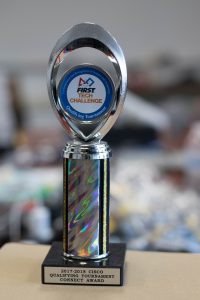Competing in San Jose

At Sacramento Adventist Academy, Capitals Engineering, the school’s First Tech Challenge robotics team has competed in 3 tournaments. Through FIRST (For Inspiration and Recognition of Science and Technology) the tournaments have been growing bigger and have been spreading awareness to other schools through robotics to encourage students to have STEM (Science, Technology, Engineering, and Mathematics) programs in their education.
The tournaments were located in San Jose, which is a two hour drive from Sacramento. All the team members were scheduled to be at school before 6:00 am to leave for San Jose. As soon as we got to the tournaments, our plan was always the same. We help to unload the excursions and set them up on our assigned area. After setting up, we will run through our presentation altogether before being seen by the judges.
When presenting to the judges we talk about our team and our robot. We lined up starting with the engineering members from one side to marketing members on the other side. The engineering team explains their hardships, the processes the robot has gone through, and what was involved to change its features. Then they demonstrate how it works and what the most import features are. The marketing team went into further depth about the team by describing our outreach to the community, such as what companies we’ve met with and what teams for which we have raised funds.
Following the judges presentation came the opening ceremony where the rules and field set up are explained. Next the matches take place. There are three parts to robot competition: qualifying rounds, semi-finals, and finals. Teams are paired up with different teams to compete in an alliance, on either the blue or the red side. There can only be two teams in an alliance at a time, with a total of four teams on the playing field.
There are many ways to score points. First is the autonomous period, which is when the robot is programed by teams to make their robot move and score points independent of any controllers for the first thirty seconds. After that, the driver controlled period begins. Foam blocks called glyphs are scored into a cryptobox, which is essentially a scoring zone. Scoring the relic is the most difficult task; on the outskirts of the playing field are two extended mats, one for each alliance team. The mats have three zones that have different points based on distance from the playing field. Bonus points are also handed out if teams can place the relic standing up. To finish it off, the robots must balance on a platform as the games come to an end.
We competed in many matches with different teams as our alliance partners. We made it to the semi-finals once but were eliminated. We all agree to stay to watch the rest of the matches because it is very fascinating to see how different teams function and compete.
The award ceremony took place after the matches have been finished. We won the Rockwell Collins Innovate award at the first tournament, the Connect award at our second tournament, and the Rockwell Collins Innovate award at our third tournament which was a regional championship with 56 teams. To celebrate we all get dinner at Taco Bell, where it is traditional to take a picture of the trophy. We head back to school after an enjoyable dinner, then go our separate ways home awaiting the next season.
